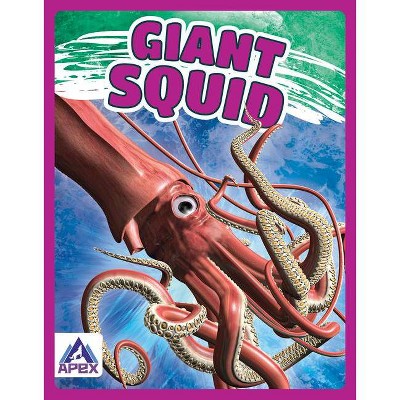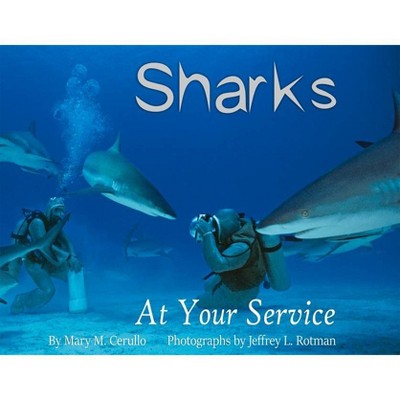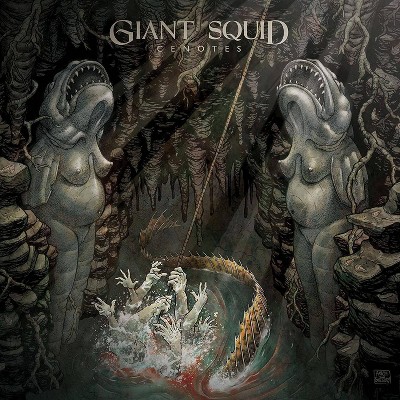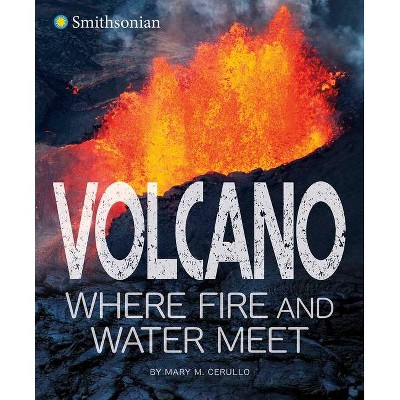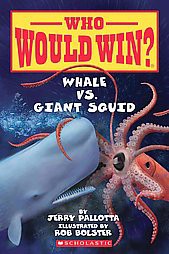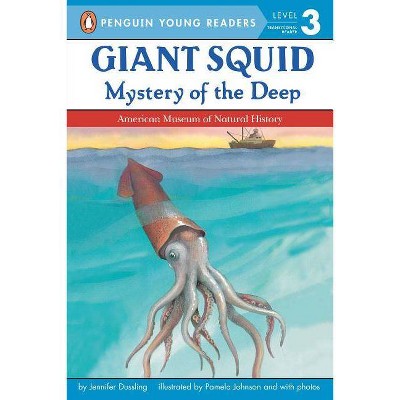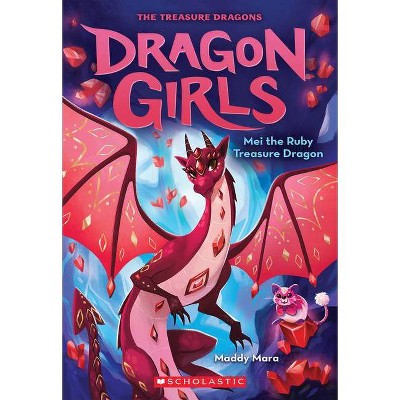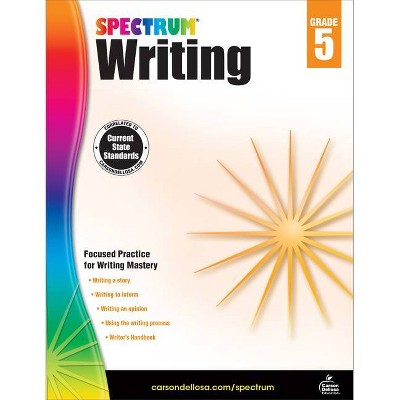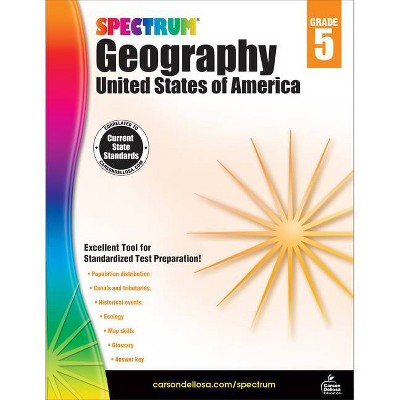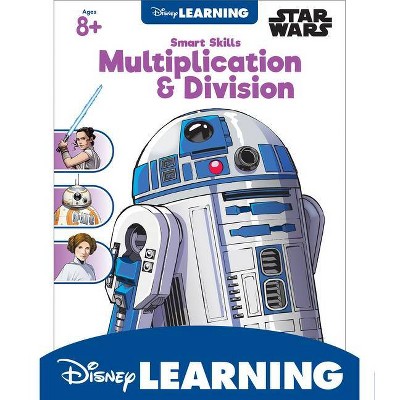Giant Squid - (Smithsonian) by Mary Cerullo (Paperback)
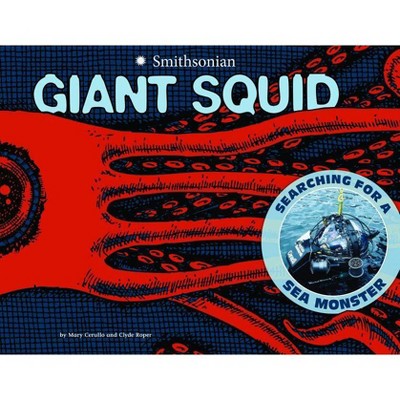
Similar Products
Products of same category from the store
AllProduct info
<p/><br></br><p><b> About the Book </b></p></br></br>"Describes the science of the giant squid and the challenges in finding and learning about this cephalopod"--<p/><br></br><p><b> Book Synopsis </b></p></br></br>This sea monster is real. It lurks in the freezing black depths of underwater canyons. Nearly 50 feet long, it hunts with its long arms and tentacles. Its powerful suckers leave giant round scars on those that live through a battle with it. But this enormous beast, with its huge, strange eyes, remains hidden from humans. We rarely see it and know little of its ways. What is this monster? The giant squid. This famed member of the cephalopod group has a history of frightening fishermen, starring in fictional adventure tales, and keeping scientists guessing. What is the story of this mythic creature? Why is it so hard to study? What secrets does it keep? Clyde Roper, ocean scientist and squid expert, has been seeking this secretive creature for decades. Come along as he and other researchers unravel its mysteries.<p/><br></br><p><b> Review Quotes </b></p></br></br><br>...covers one of the best booktalk topics ever. The giant squid lives so deep in the ocean that for centuries, most people didn't believe it existed.-- "School Library Journal, Nonfiction Booktalker: What Lies Beneath"<br><br>A fascinating look at the search for a real-life sea monster. . . .The book is visually appealing and informative, using photos and illustrations to accompany the text. There are some jaw-droppers here, and the images of live giant squid at the end of the book will draw a lot of deserved attention. A book that will hold pleasure reading and fact-finding appeal, Giant Squid is a worthy addition to your collection.-- "SLJ's 100 Scope Notes blog"<br><br>Awesome nonfiction text about the search for the giant squid, alive and in its natural habitat. As a teacher with little squid hunters in my own classroom, this book is especially relevant and exciting to add to my classroom library.-- "Blue Stocking Thinking blog"<br><br>Beginning with a history of human encounters with giant squids, the authors go on to detail the personal experiences of teuthologist Roper in studying this mysterious cephalopod. Numerous photographs, drawings, diagrams, and intriguing sidebars enhance the text.-- "School Library Monthly"<br><br>Best 2012 Science Books for Middle Grades.-- "Growing With Science blog"<br><br>Cerullo traces both the search for the mythic monster of the deep described by seafarers and author Jules Verne and the modern quest of coauthor Roper, a zoologist and squid researcher. Photos, drawings, and amps document past conjectures and recent discoveries. The text may challenge young readers, but they'll be drawn to the account when it is read aloud and discussed.-- "School Library Journal, Grunt, Quack, Oink (Focus On: Animals)"<br><br>Great and informative.-- "NetGalley Review"<br><br>Great pictures, easy to read text. Highly recommended for grade schoolers!-- "NetGalley Review"<br><br>I would definitely recommend it to my students, both for topic research, and for personal interest.-- "NetGalley Review"<br><br>If you find these real-life sea monsters fascinating, you will definitely want to check out this new non-fiction book. . . .The book has many illustrations and photographs (some of them fantastically gross!) and may appeal to reluctant readers. I highly recommend it!-- "Susan the Librarian blog"<br><br>Join a teuthologist on his quest to study giant squids in their natural habitat, learn how giant squids are an intrinsic part of ocean ecosystems, and develop a craving for calamari as you devour interesting information about giant squids. Readers of all ages will enjoy this book for its well-presented facts, bright illustrations, and photographs.-- "Children's Literature Comprehensive Database"<br><br>Krakens, giant squid, and other such monsters have inhabited legend and frightened sailors for centuries. Using scientific inquiry, Dr. Clyde Roper and other cephalopod experts have uncovered some major truths about the very real giant squid, which averages 46 feet long. Cerullo follows the research and recounts the discoveries of new information about the elusive mollusk. Sightings are rare with only 500 giant squid specimens on hand. The colorful layout, extraordinary photographs, fascinating facts, and detailed diagrams will inspire students to ask even more questions and perhaps emulate the dedicated scientists who solve mysteries like this. With eyes the size of car headlights, a beak sharp enough to bite through steel, and an aggressive personality, the giant squid will not disappoint any reader on the lookout for oceanic adventure. Recommended.-- "Library Media Connection"<br><br>The book's lively style, fascinating scientific facts and attractive layout make this a must for any child curious about life under the ocean.-- "NetGalley Review"<br><br>The facts, photographs, and illustrations are woven together well. The effect is a true life adventure story that will educate while entertaining. I think that Giant Squid: Searching for a Sea Monster would be perfect for any nonfiction collection intended for elementary school students-- "Yahoo! Contributor Network"<br><br>The scientific work of Dr. Clyde Roper is featured in this fascinating look at the mysterious deep-sea creature, the giant squid. . . .Illustrated with a mix of actual photographs, charts, diagrams and illustrations this narrative provides an enormous amount of factual information about this little-known subject in addition to pieces of some of the sea lore that surrounds them. Sightings of these rare animals are few partly because they live in the freezing depths of the ocean usually from 1,600 to 3,300 feet below sea level. How scientists have used photography to search and study these elusive creatures combined with the fact that a giant squid has never been captured or observed within their own environment makes fascinating account. This text was selected as an Outstanding Science Trade Book for 2013.-- "Reading Today Online"<br><br>The writing is engaging and perfect for reluctant readers. Cerullo keeps the excitement building throughout . . . .A fine example of science books for children.-- "Nonfiction Book Detectives blog"<br><br>This 48-page, hardcover book is devoted to a single topic: the giant squid, though pictures and descriptions of similar organisms are covered as well. The book begins with historical accounts and early evidence of the giant squid's existence. There is photographic evidence presented, dated back to 1873 in Newfoundland, of giant squid bodies being hauled up in fishermen's net. People followed the evidence that such a creature existed, but it was often included in stories with Bigfoot and the Loch Ness Monster. The adventures of science researcher Clyde Roper and his colleagues are featured throughout the book as they search for more information about the mysterious creature described over centuries of sightings. A description of Roper's close encounter with a Humboldt squid is accompanied by photos of this large and dangerous creature. The search for this squid is used as the basis for a chapter on how scientists solve mysteries, including finding clues, and using autopsies and instruments to observe and track organisms of interest. The readability of this book is aimed at children in grades 2 through 6, and the provided visuals will catch the interest of younger children who like to read about monsters. There is an index, a glossary, and web links provided for those children motivated to learn more about giant squid and related topics. This would be a good addition to a classroom or library book shelf where children can select their free-time reading materials.-- "Science & Children"<br><br>Though yet to be observed in its natural environment, the giant squid (and its heavier Antarctic cousin, the colossal squid) is slowly giving up its secrets thanks to Clyde Roper, one of the world's leading teuthologists. Along with a quick tally of historical encounters with the creatures, this presents accounts of several of Roper's undersea expeditions--along with those of Japanese expert Tsunemi Kubodera--and summarizes in clear, simple language what has been learned or inferred about the monsters' physical structures, behavior, and life cycle. Some memorable color photos, including views of Roper laying down beside a dead squid to show its length, posing next to a headlamp-size eyeball, and deep in the bloody guts of a recently beached sperm whale add plenty of visual appeal (of a sort) to the generous array of charts, maps, and painted images. This makes rewarding reading for fans of the Scientists in the Field series, or anyone interested in learning more about some of the world's largest and most outstandingly alien-looking animals.-- "Booklist"<br><br>TWO STARS! Searching for the giant squid is an endeavor that invariably appeals to most children and adults as well. The images are almost all in color, involving drawings of early reports of sailor/giant squid interactions, photographs of squid relatives, scientists performing various steps in research (including whale autopsies and deployment of cameras from ships), preserved giant squids, anatomical parts of squid, and images from the first videos taken of live giant squid in the wild. In all, the book is largely filled with pictures that catch the eye, with accompanying text to explain the images. However, the images are nicely dovetailed to tell a coherent, comprehensive narrative. The second author is a squidhunting scientist himself (a zoologist with the Smithsonian Institution), and so the book largely describes his passionate search for these animals, outlining his childhood dreams and thought process through his adult scientific hunt while continually using his first name so that the process of scientific inquiry comes alive through his personal lens. The various pieces of information that led Clyde to look for the squid in different places, and his repeated tantalizing, but ultimately disappointing, findings of the ecosystem they inhabit are honestly portrayed. The exciting work leading up to the filming of the giant squid by the Japanese scientist Dr. Tsunemi Kubodera is outlined, and again the amount of time that such discoveries take (23 trips over 3 years) is honestly portrayed. One of the nice things about this book is that it personalizes the scientists and the hard work they must do, sometimes with disappointing results, but also the fact that the scientists remain excited about their ultimate goal. This message, that science takes time and perseverance and does not always work the way scientists might like, is an important one for students to hear. At the end of the book, what has been learned and some of the remaining questions are itemized. The book ends with a brief glossary and books and websites for further information. In all, besides the lovely images and exciting topic, the strength of this book is the personalization of the scientist and the idea that science is a continuous and gradual process of information gathering that often takes many years, or even a lifetime.-- "Science Books & Films"<br>
Price History
Cheapest price in the interval: 7.89 on October 22, 2021
Most expensive price in the interval: 7.89 on November 8, 2021
Price Archive shows prices from various stores, lets you see history and find the cheapest. There is no actual sale on the website. For all support, inquiry and suggestion messagescommunication@pricearchive.us
